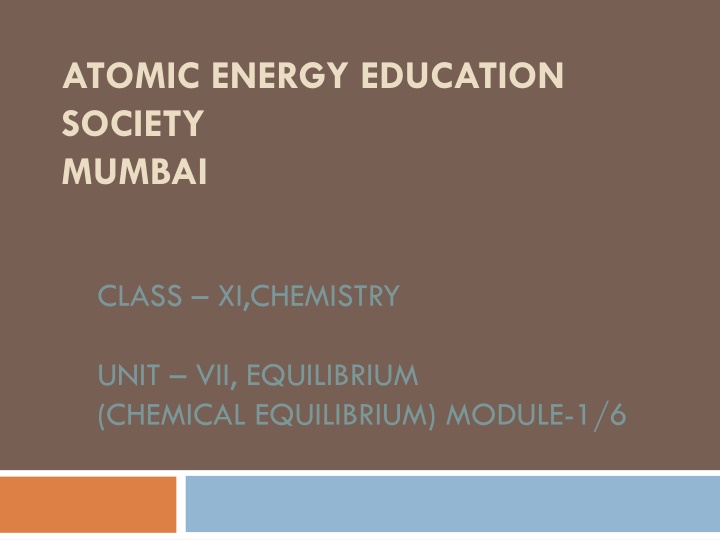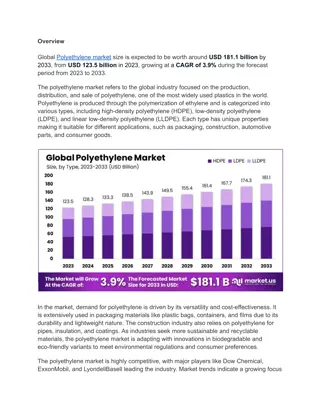
Chemical Equilibrium in Physical Changes
Explore the concept of equilibrium in physical changes through examples like solid-liquid, liquid-gas, and solid-gas equilibriums, illustrating how temperature and states of matter play a crucial role in maintaining balance. Discover the dynamics of equilibrium in different phases of matter.
Download Presentation

Please find below an Image/Link to download the presentation.
The content on the website is provided AS IS for your information and personal use only. It may not be sold, licensed, or shared on other websites without obtaining consent from the author. If you encounter any issues during the download, it is possible that the publisher has removed the file from their server.
You are allowed to download the files provided on this website for personal or commercial use, subject to the condition that they are used lawfully. All files are the property of their respective owners.
The content on the website is provided AS IS for your information and personal use only. It may not be sold, licensed, or shared on other websites without obtaining consent from the author.
E N D
Presentation Transcript
ATOMIC ENERGY EDUCATION SOCIETY MUMBAI CLASS XI,CHEMISTRY UNIT VII, EQUILIBRIUM (CHEMICAL EQUILIBRIUM) MODULE-1/6
INTRODUCTION Equilibrium is a state at which concentration of reactants and products do not change with time. At this rates of forward and backward reactions are same and do not change with time. The reaction parameters such as temperature, pressure, concentration etc. are kept constant. Equilibrium is dynamic process at which both forward and backward processes are continued. This type of processes never complete. It is indicated by two half arrows pointing the reactions in both the directions ( )
EQUILIBEIUM INVOLVING PHYSICAL CHANGES In physical equilibrium only physical states of initial and final state of materials are changed. There is no any change in their chemical compositions. On the basis of states of substances, physical equilibrium are following types:
(i). Solid Liquid Equilibrium: This equilibrium is achieved at fusion temperature of the solid. Temperature of the system is maintained at fusion temperature in a closed vessel. Example: H2O(s) H2O(l) Rate of melting = Rate of freezing This equilibrium also gives the concept of melting point. At 1 atm pressure the temperature at which solid and liquid phases both coexist and they are in equilibrium called melting point of solid or freezing point of the liquid.
(ii) Liquid Gas Equilibrium: A volatile liquid starts vaporising in a close container. Condensation of vapours also starts when vaporisation takes place. At equilibrium both vaporisation and condensation rates become equal. Example: H2O(l) Rate of evaporation = Rate of condensation H2O(vap)
(iii) Solid Gas Equilibrium: (Sublimation equilibrium) Sublime substances such as iodine, camphor, naphthalene ammonium chloride etc. exhibit equilibrium with their vapours in a close container. This is solid gas equilibrium. Example: I2(s) I2(vap) Rate of sublimation = Rate of solidification
(iv) Solid-in Liquid Equilibrium: Those solids which are soluble in a liquid like water attain equilibrium after getting their saturated solution at a certain temperature. Example: NaCl(s) NaCl(aq)in aqueous medium Rate of dissolution = Rate of solidification
(v) Gas in - Liquid equilibrium: This equilibrium arise when a gas is soluble in a liquid like water. After getting saturated solution, there is an equilibrium in dissolved gas and undissolved gas. Example: Dissolution of carbon dioxide in water CO2(g) CO2(g) in aqueous medium, Solubility of the gas is derived by Henry s law. According to this law: Mass of the gas dissolved in a given volume of liquid at certain temperature is proportional to the pressure of the gas.
Hence or constant m P at constant temperature m = kP where k is proportionality Conditions: a) Pressure should not be very high b)Temperature should not be very low c) The gas should not be highly soluble and does not react d) The gas does not dissociate
O2 Solubility N2 He . Pressure(atm) Variation of solubility of gas with pressure Applications: It is applied in preparation of carbonated drinks, sea diving, mountain climbing etc.






















